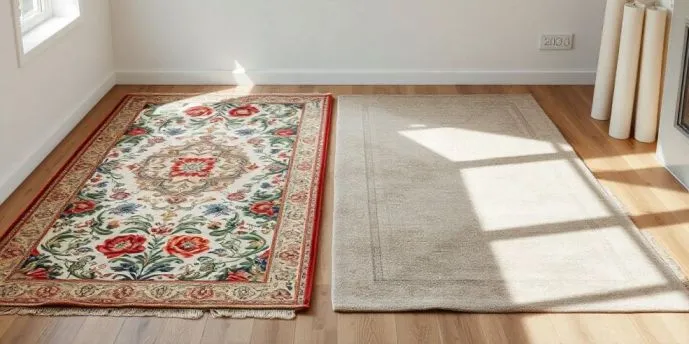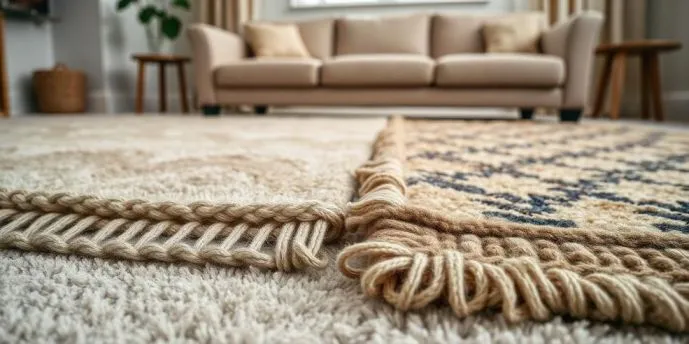Before distinguishing Handmade and Machine-Made Rugs, it is important for us to that rug-making has been an integral part of cultures worldwide for thousands of years. Each item is a work of art that a skilled weaver has crafted. Depending on the size of the rug, a weaver may take days, weeks, or even years to complete each section by manually tying each knot. Hand-knotted pile rugs, made from thousands of knotted strands of material, still are a highly respected art form, symbolizing culture, civilizations, and religions.
One of the reasons why handmade rugs are more expensive is because making them is a complex, time-consuming operation. Weaving a carpet with perfect thickness is an art form that demands incredible expertise and skill. Each strand must be meticulously placed, showcasing the artisan’s dedication to their craft. It is challenging for an ordinary person to differentiate between handmade and machine-made rugs.

The Mechanical Marvel: The Rise of Machine-Made Rugs
There have been countless reports of consumers being deceived into purchasing machine-made rugs purported to be handcrafted. In 2016, a woman in Victoria was tricked out of $ 15,000 after she bought three high-quality rugs that turned out to be machine-manufactured rather than handmade.
Furthermore, in 2019, two men in Portugal attempted to sell rugs that they claimed were handcrafted Persian rugs for a premium price. The rugs turned out to be machine-made forgeries. Information from the men’s receipt books revealed that several people had been tricked by the scam and duped out of thousands of dollars.
Advantage of QR Code Distinguishing Handmade and Machine-Made Rugs
In Jammu and Kashmir, a union territory of India, a Geographical Indication (GI) register for the famous Kashmiri rug was established, along with a quick response (QR) code including information about the artisans and the material . The QR code linked to the GI tag will aid in verifying the authenticity of the hand-knotted rugs by providing relevant information such as the maker, weaver, district, raw material, etc. The QR code label cannot be copied or misused. It will discourage the creation of counterfeit rugs, which concerns the livelihoods of weavers and the industry. This breakthrough would help in preserving the quality of hand-knotted rugs.
The main disadvantage of the GI tag is that it is a centralized method of differentiating between rug types, and it only works on rugs branded in the current market of Jammu and Kashmir, making it available to only 0.001% of the world’s population. Furthermore, as it was only introduced in 2022, it would not function on rugs brought before its commencement. Unfortunately, no work has been done on a global scale to differentiate between handmade and machine-made rugs.
Related Work
If we talk about related work, an extensive research has been conducted in the field of carpets, but unfortunately, no research has been done to distinguish between handmade and machine-made rugs using image classification. K. K. Goswami gave a general overview of handmade carpets and covered different terminologies in carpets. He also wrote about the history of handmade carpets and modern handmade carpet production. Y. Wu, B. Pourdeyhimi, and S. M. Spivak evaluated carpets based on texture using image analysis. Their research explored new image enhancement techniques for assessing tuft geometry and concomitant appearance changes in new and worn carpets. Some limitations of texture-sensitive image analysis techniques were also discussed.
In an intriguing study, Copot and colleagues explored the world of carpet wear by employing a support vector machine pattern recognition approach for classification. This innovative technique sheds light on how different wear patterns on carpets can be identified and analyzed, paving the way for more effective maintenance and care strategies. They presented a new strategy for analyzing textures on carpet surface data taken using a 3D laser scanner, which provides both structural and intensity information. They were able to achieve an average of over 90% correct classification.
Ming Li, C. Ham, and Y. Wang developed an innovative method for assessing the similarity between two carpet images, enhancing the accuracy and efficiency of image analysis in this field. An automatic grouping and arranging algorithm of carpet images was presented. The feature vector of each carpet image was extracted using a pre-trained deep-learning model. The carpet images were creatively grouped into different clusters, and through the magic of a genetic algorithm, they discovered the perfect arrangement that brought them all to life! The experimental results showed that the proposed approach was practical.
Sayadeh Marjaneh Hosseini, A. Mohhamad-Djafari, A. Mohammadpour, S. Mohammadpour, and M. Nadi proposed carpet color and pattern detection. The results were acceptable despite the low accuracy because color ranges were not well defined, and the network mostly confused resemblant colors like beige and ivory. Manual Process of Rug Identification The weaving method used to create the rug is one of the most crucial factors in determining a rug’s quality.
The Rug Verification: A Technological Outlook
The durability and overall value of a rug can be significantly influenced by even the slightest variations in its construction characteristics. The rug is finished off with fringes made from the warps of the rug itself. Rug producers wrap hand-knotted wool strands around these warps. Each strand runs from one end to the opposite side of the rug.
The rug maker reinforces the rug’s base with the fringe. The characteristics of the fringe help determine whether the rug was made by hand or by a machine. A handmade rug typically has a fringe that extends the rug itself. In contrast, if the fringe appears separate or uniform, the rug was likely manufactured using a machine. The underside of a carpet is called backing. In addition to strengthening and stabilizing the carpet’s dimensions, it secures the tufts.
The type of material used to create carpet backings might vary depending on the requirements of the rug. When looking at rugs from the back, if one notices that the back is not ideally even, this indicates that the rug is handmade and every knot was tied by hand. The more details on the rug’s backside, the higher the quality of the rug. There are two ways by which we can distinguish between a handmade rug and a machine-made one through image classification. The first point of difference is the fringe of the rug, and the second one is the back of the rug, as depicted in picture below.
A close-up view shows a hand-made rug with visible knots and textures. In contrast, a machine-made rug has a flat surface and uniform patterns. Both rugs are placed on a soft carpet in a cozy living room, with an elegant sofa in the background.

Conclusion
The conclusion of blog is ,there is an urgent need for a reliable way to tell the difference between handmade and machine-made rugs. Many consumers get tricked, and new image classification technology, especially Convolutional Neural Networks, can help solve this problem. By creating a system like this, we can protect the rug market’s integrity, benefiting both artisans and consumers.
